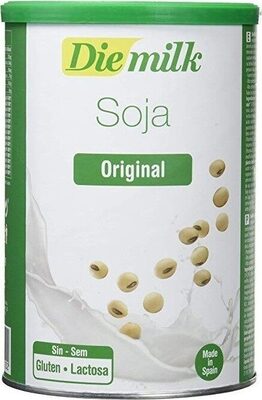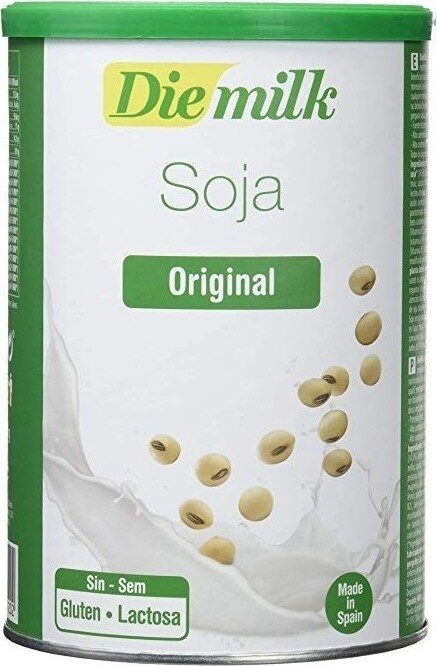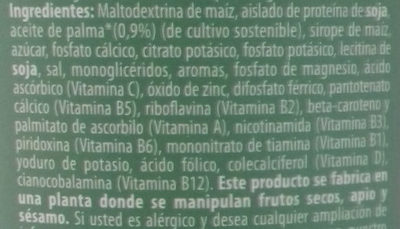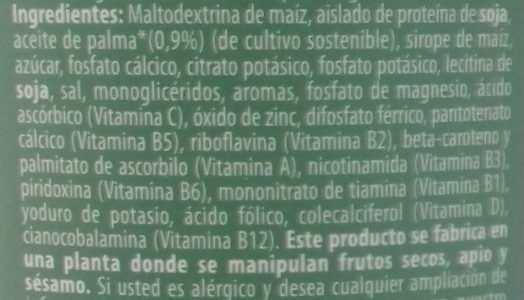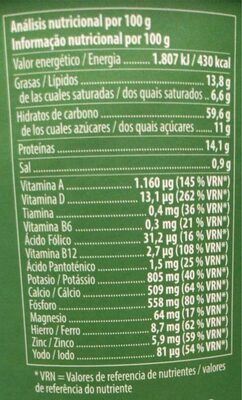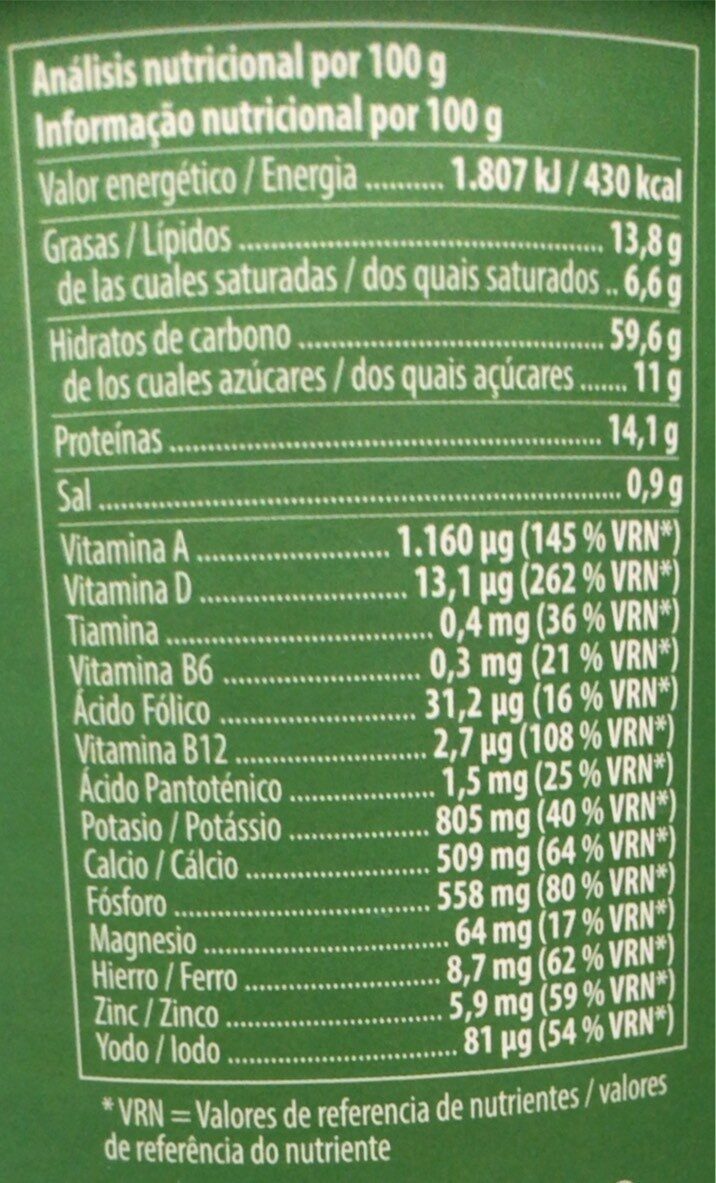Help us make food transparency the norm!
As a non-profit organization, we depend on your donations to continue informing consumers around the world about what they eat.
The food revolution starts with you!
Die milk soja original - DieMilk - 400 g
Die milk soja original - DieMilk - 400 g
This product page is not complete. You can help to complete it by editing it and adding more data from the photos we have, or by taking more photos using the app for Android or iPhone/iPad. Thank you!
×
Barra-kodea: 8428532181202 (EAN / EAN-13)
Izen arrunta: Bebida instantánea de soja
Kopurua: 400 g
Ontziratzea: en:Metal, en:Pot, en:container
Markak: DieMilk
Kategoriak: en:Plant-based foods and beverages, en:Plant-based foods, en:Legumes and their products, en:Powdered plant milks, en:Powdered legume milks, en:Powdered soy milks
Etiketak, ziurtagiriak, sariak: en:No gluten, en:No GMOs, Source of proteins, High in calcium, High proteins, en:Made in Spain, en:No lactose, es:Alto contenido de fósforo
Manufacturing or processing places: España
Traceability code: R.G.S.A.: 26.02836/MU
Link to the product page on the official site of the producer: http://www.ecomil.com/sin-lactosa-sans-l...
Dendak: Carrefour, Hipercor, El Corte Inglés
Saltzen diren herrialdeak: Espainia
Matching with your preferences
Health
Osagaiak
-
37 ingredients
: Maltodextrina de maíz, aislado de proteína de soja, aceite de palma (0,9%) (de cultivo sostenible), sirope de maíz, azúcar, fosfato cálcico, citrato potásico, fosfato potásico, lecitina de soja, sal, monoglicéridos, aromas, fosfato de magnesio, ácido ascórbico (Vitamina C), óxido de zinc, difosfato férrico, pantotenato cálcico (Vitamina B5), riboflavina (Vitamina B2), beta-caroteno y palmitato de ascorbilo (Vitamina A), nicotinamida (Vitamina B3), piridoxina (Vitamina B6), mononitrato de tiamina (Vitamina B1), yoduro de potasio, ácido fólico, colecalciferol (VitaminaD), cianocobalamina (Vitamina B12).Alergenoak: en:SoybeansAztarnak: en:Celery, en:Nuts, en:Sesame seeds
Food processing
-
Ultra processed foods
Elements that indicate the product is in the 4 - Ultra prozesatutako elikagaiak eta edariak group:
- Gehigarria: E322
- Osagaia: Flavouring
- Osagaia: Maltodextrin
Food products are classified into 4 groups according to their degree of processing:
- Prozesatu gabeko edo ahalik eta gutxien prozesatutako elikagaiak
- Sukaldaritzako osagaiak prozesatu
- Prozesatutako jakiak
- Ultra processed foods
The determination of the group is based on the category of the product and on the ingredients it contains.
Gehigarriak
-
E304
Ascorbyl palmitate: Ascorbyl palmitate is an ester formed from ascorbic acid and palmitic acid creating a fat-soluble form of vitamin C. In addition to its use as a source of vitamin C, it is also used as an antioxidant food additive -E number E304-. It is approved for use as a food additive in the EU, the U.S., Canada, Australia, and New Zealand.Ascorbyl palmitate is known to be broken down -through the digestive process- into ascorbic acid and palmitic acid -a saturated fatty acid- before being absorbed into the bloodstream. Ascorbyl palmitate is also marketed as "vitamin C ester".Source: Wikipedia (Ingeles)
-
E304i
Ascorbyl palmitate: Ascorbyl palmitate is an ester formed from ascorbic acid and palmitic acid creating a fat-soluble form of vitamin C. In addition to its use as a source of vitamin C, it is also used as an antioxidant food additive -E number E304-. It is approved for use as a food additive in the EU, the U.S., Canada, Australia, and New Zealand.Ascorbyl palmitate is known to be broken down -through the digestive process- into ascorbic acid and palmitic acid -a saturated fatty acid- before being absorbed into the bloodstream. Ascorbyl palmitate is also marketed as "vitamin C ester".Source: Wikipedia (Ingeles)
-
E322
Lecithin: Lecithin -UK: , US: , from the Greek lekithos, "egg yolk"- is a generic term to designate any group of yellow-brownish fatty substances occurring in animal and plant tissues, which are amphiphilic – they attract both water and fatty substances -and so are both hydrophilic and lipophilic-, and are used for smoothing food textures, dissolving powders -emulsifying-, homogenizing liquid mixtures, and repelling sticking materials.Lecithins are mixtures of glycerophospholipids including phosphatidylcholine, phosphatidylethanolamine, phosphatidylinositol, phosphatidylserine, and phosphatidic acid.Lecithin was first isolated in 1845 by the French chemist and pharmacist Theodore Gobley. In 1850, he named the phosphatidylcholine lécithine. Gobley originally isolated lecithin from egg yolk—λέκιθος lekithos is "egg yolk" in Ancient Greek—and established the complete chemical formula of phosphatidylcholine in 1874; in between, he had demonstrated the presence of lecithin in a variety of biological matters, including venous blood, in human lungs, bile, human brain tissue, fish eggs, fish roe, and chicken and sheep brain. Lecithin can easily be extracted chemically using solvents such as hexane, ethanol, acetone, petroleum ether, benzene, etc., or extraction can be done mechanically. It is usually available from sources such as soybeans, eggs, milk, marine sources, rapeseed, cottonseed, and sunflower. It has low solubility in water, but is an excellent emulsifier. In aqueous solution, its phospholipids can form either liposomes, bilayer sheets, micelles, or lamellar structures, depending on hydration and temperature. This results in a type of surfactant that usually is classified as amphipathic. Lecithin is sold as a food additive and dietary supplement. In cooking, it is sometimes used as an emulsifier and to prevent sticking, for example in nonstick cooking spray.Source: Wikipedia (Ingeles)
-
E322i - Lezitina
Lecithin: Lecithin -UK: , US: , from the Greek lekithos, "egg yolk"- is a generic term to designate any group of yellow-brownish fatty substances occurring in animal and plant tissues, which are amphiphilic – they attract both water and fatty substances -and so are both hydrophilic and lipophilic-, and are used for smoothing food textures, dissolving powders -emulsifying-, homogenizing liquid mixtures, and repelling sticking materials.Lecithins are mixtures of glycerophospholipids including phosphatidylcholine, phosphatidylethanolamine, phosphatidylinositol, phosphatidylserine, and phosphatidic acid.Lecithin was first isolated in 1845 by the French chemist and pharmacist Theodore Gobley. In 1850, he named the phosphatidylcholine lécithine. Gobley originally isolated lecithin from egg yolk—λέκιθος lekithos is "egg yolk" in Ancient Greek—and established the complete chemical formula of phosphatidylcholine in 1874; in between, he had demonstrated the presence of lecithin in a variety of biological matters, including venous blood, in human lungs, bile, human brain tissue, fish eggs, fish roe, and chicken and sheep brain. Lecithin can easily be extracted chemically using solvents such as hexane, ethanol, acetone, petroleum ether, benzene, etc., or extraction can be done mechanically. It is usually available from sources such as soybeans, eggs, milk, marine sources, rapeseed, cottonseed, and sunflower. It has low solubility in water, but is an excellent emulsifier. In aqueous solution, its phospholipids can form either liposomes, bilayer sheets, micelles, or lamellar structures, depending on hydration and temperature. This results in a type of surfactant that usually is classified as amphipathic. Lecithin is sold as a food additive and dietary supplement. In cooking, it is sometimes used as an emulsifier and to prevent sticking, for example in nonstick cooking spray.Source: Wikipedia (Ingeles)
-
E340
Potassium phosphate: Potassium phosphate is a generic term for the salts of potassium and phosphate ions including: Monopotassium phosphate -KH2PO4- -Molar mass approx: 136 g/mol- Dipotassium phosphate -K2HPO4- -Molar mass approx: 174 g/mol- Tripotassium phosphate -K3PO4- -Molar mass approx: 212.27 g/mol-As food additives, potassium phosphates have the E number E340.Source: Wikipedia (Ingeles)
Ingredients analysis
-
en:Palm oil
Ingredients that contain palm oil: Palmondo olio
-
en:Vegan status unknown
Unrecognized ingredients: es:de-cultivo-sostenible, es:citrato-potasico, es:monogliceridos, C bitamina, en:Zinc oxide, en:Ferric diphosphate, es:pantotenato-calcico, en:Thiamin mononitrate, Tiamina, Azido foliko, es:vitaminad, en:Cyanocobalamin, KobalaminaSome ingredients could not be recognized.
We need your help!
You can help us recognize more ingredients and better analyze the list of ingredients for this product and others:
- Edit this product page to correct spelling mistakes in the ingredients list, and/or to remove ingredients in other languages and sentences that are not related to the ingredients.
- Add new entries, synonyms or translations to our multilingual lists of ingredients, ingredient processing methods, and labels.
If you would like to help, join the #ingredients channel on our Slack discussion space and/or learn about ingredients analysis on our wiki. Thank you!
-
en:Vegetarian status unknown
Unrecognized ingredients: es:de-cultivo-sostenible, es:citrato-potasico, es:monogliceridos, C bitamina, en:Zinc oxide, en:Ferric diphosphate, es:pantotenato-calcico, en:Thiamin mononitrate, Tiamina, Azido foliko, es:vitaminad, en:Cyanocobalamin, KobalaminaSome ingredients could not be recognized.
We need your help!
You can help us recognize more ingredients and better analyze the list of ingredients for this product and others:
- Edit this product page to correct spelling mistakes in the ingredients list, and/or to remove ingredients in other languages and sentences that are not related to the ingredients.
- Add new entries, synonyms or translations to our multilingual lists of ingredients, ingredient processing methods, and labels.
If you would like to help, join the #ingredients channel on our Slack discussion space and/or learn about ingredients analysis on our wiki. Thank you!
-
Details of the analysis of the ingredients
We need your help!
Some ingredients could not be recognized.
We need your help!
You can help us recognize more ingredients and better analyze the list of ingredients for this product and others:
- Edit this product page to correct spelling mistakes in the ingredients list, and/or to remove ingredients in other languages and sentences that are not related to the ingredients.
- Add new entries, synonyms or translations to our multilingual lists of ingredients, ingredient processing methods, and labels.
If you would like to help, join the #ingredients channel on our Slack discussion space and/or learn about ingredients analysis on our wiki. Thank you!
: Maltodextrina de maíz, aislado de proteína de _soja_, aceite de palma 0.9% (de cultivo sostenible), sirope de maíz, azúcar, fosfato cálcico, citrato potásico, fosfato potásico, lecitina de _soja_, sal, monoglicéridos, aromas, fosfato de magnesio, ácido ascórbico (Vitamina C), óxido de zinc, difosfato férrico, pantotenato cálcico (Vitamina B5), riboflavina (Vitamina B2), beta-caroteno, palmitato de ascorbilo (Vitamina A), nicotinamida (Vitamina B3), piridoxina (Vitamina B6), mononitrato de tiamina (Vitamina B1), yoduro de potasio, ácido fólico, colecalciferol (VitaminaD), cianocobalamina (Vitamina B12)- Maltodextrina de maíz -> en:corn-maltodextrin - vegan: yes - vegetarian: yes - percent_min: 27.95 - percent_max: 98.2
- aislado de proteína de _soja_ -> en:soy-protein-isolate - vegan: yes - vegetarian: yes - ciqual_food_code: 20591 - percent_min: 0.9 - percent_max: 49.55
- aceite de palma -> en:palm-oil - vegan: yes - vegetarian: yes - from_palm_oil: yes - ciqual_food_code: 16129 - percent_min: 0.9 - percent: 0.9 - percent_max: 0.9
- de cultivo sostenible -> es:de-cultivo-sostenible - percent_min: 0.9 - percent_max: 0.9
- sirope de maíz -> en:corn-syrup - vegan: yes - vegetarian: yes - ciqual_proxy_food_code: 31089 - percent_min: 0 - percent_max: 0.9
- azúcar -> en:sugar - vegan: yes - vegetarian: yes - ciqual_proxy_food_code: 31016 - percent_min: 0 - percent_max: 0.9
- fosfato cálcico -> en:e341 - vegan: yes - vegetarian: yes - percent_min: 0 - percent_max: 0.9
- citrato potásico -> es:citrato-potasico - percent_min: 0 - percent_max: 0.9
- fosfato potásico -> en:e340 - vegan: yes - vegetarian: yes - percent_min: 0 - percent_max: 0.9
- lecitina de _soja_ -> en:soya-lecithin - vegan: yes - vegetarian: yes - ciqual_food_code: 42200 - percent_min: 0 - percent_max: 0.9
- sal -> en:salt - vegan: yes - vegetarian: yes - ciqual_food_code: 11058 - percent_min: 0 - percent_max: 0.9
- monoglicéridos -> es:monogliceridos - percent_min: 0 - percent_max: 0.9
- aromas -> en:flavouring - vegan: maybe - vegetarian: maybe - percent_min: 0 - percent_max: 0.9
- fosfato de magnesio -> en:e343i - vegan: yes - vegetarian: yes - percent_min: 0 - percent_max: 0.9
- ácido ascórbico -> en:e300 - vegan: yes - vegetarian: yes - percent_min: 0 - percent_max: 0.9
- Vitamina C -> en:vitamin-c - percent_min: 0 - percent_max: 0.9
- óxido de zinc -> en:zinc-oxide - percent_min: 0 - percent_max: 0.9
- difosfato férrico -> en:ferric-diphosphate - percent_min: 0 - percent_max: 0.9
- pantotenato cálcico -> es:pantotenato-calcico - percent_min: 0 - percent_max: 0.9
- Vitamina B5 -> en:pantothenic-acid - vegan: yes - vegetarian: yes - percent_min: 0 - percent_max: 0.9
- riboflavina -> en:e101 - vegan: maybe - vegetarian: yes - percent_min: 0 - percent_max: 0.9
- Vitamina B2 -> en:e101 - vegan: maybe - vegetarian: yes - percent_min: 0 - percent_max: 0.9
- beta-caroteno -> en:e160ai - vegan: maybe - vegetarian: maybe - from_palm_oil: maybe - percent_min: 0 - percent_max: 0.9
- palmitato de ascorbilo -> en:e304i - vegan: yes - vegetarian: yes - from_palm_oil: maybe - percent_min: 0 - percent_max: 0.9
- Vitamina A -> en:vitamin-a - vegan: yes - vegetarian: yes - percent_min: 0 - percent_max: 0.9
- nicotinamida -> en:e375 - vegan: maybe - vegetarian: maybe - percent_min: 0 - percent_max: 0.9
- Vitamina B3 -> en:e375 - vegan: maybe - vegetarian: maybe - percent_min: 0 - percent_max: 0.9
- piridoxina -> en:vitamin-b6 - vegan: yes - vegetarian: yes - percent_min: 0 - percent_max: 0.9
- Vitamina B6 -> en:vitamin-b6 - vegan: yes - vegetarian: yes - percent_min: 0 - percent_max: 0.9
- mononitrato de tiamina -> en:thiamin-mononitrate - percent_min: 0 - percent_max: 0.9
- Vitamina B1 -> en:thiamin - percent_min: 0 - percent_max: 0.9
- yoduro de potasio -> en:potassium-iodide - vegan: yes - vegetarian: yes - ciqual_food_code: 11058 - percent_min: 0 - percent_max: 0.9
- ácido fólico -> en:folic-acid - percent_min: 0 - percent_max: 0.9
- colecalciferol -> en:cholecalciferol - vegan: maybe - vegetarian: maybe - percent_min: 0 - percent_max: 0.9
- VitaminaD -> es:vitaminad - percent_min: 0 - percent_max: 0.9
- cianocobalamina -> en:cyanocobalamin - percent_min: 0 - percent_max: 0.9
- Vitamina B12 -> en:vitamin-b12 - percent_min: 0 - percent_max: 0.9
Elikadura
-
Poor nutritional quality
⚠ ️Abisua: zuntz kopurua ez dago zehaztuta, ezin izan dute kontuan izan kalifikaziorako izan dezaketen ekarpen positiboa.⚠ ️Warning: the amount of fruits, vegetables and nuts is not specified on the label, it was estimated from the list of ingredients: 0This product is not considered a beverage for the calculation of the Nutri-Score.
Positive points: 0
- Proteinak: 5 / 5 (balioa: 14.1, rounded value: 14.1)
- Fiber: 0 / 5 (balioa: 0, rounded value: 0)
- Fruits, vegetables, nuts, and colza/walnut/olive oils: 0 / 5 (balioa: 0, rounded value: 0)
Negative points: 14
- Energia: 5 / 10 (balioa: 1799, rounded value: 1799)
- Azukreak: 0 / 10 (balioa: 1, rounded value: 1)
- Gantz saturatua: 6 / 10 (balioa: 6.6, rounded value: 6.6)
- Sodioa: 3 / 10 (balioa: 360, rounded value: 360)
The points for proteins are not counted because the negative points are greater or equal to 11.
Nutritional score: (14 - 0)
Nutri-Score:
-
Nutrient levels
-
Koipe in moderate quantity (13.8%)
What you need to know- A high consumption of fat, especially saturated fats, can raise cholesterol, which increases the risk of heart diseases.
Recommendation: Limit the consumption of fat and saturated fat- Choose products with lower fat and saturated fat content.
-
Gantz-azido ase in high quantity (6.6%)
What you need to know- A high consumption of fat, especially saturated fats, can raise cholesterol, which increases the risk of heart diseases.
Recommendation: Limit the consumption of fat and saturated fat- Choose products with lower fat and saturated fat content.
-
Azukre in low quantity (1%)
What you need to know- A high consumption of sugar can cause weight gain and tooth decay. It also augments the risk of type 2 diabetes and cardio-vascular diseases.
Recommendation: Limit the consumption of sugar and sugary drinks- Sugary drinks (such as sodas, fruit beverages, and fruit juices and nectars) should be limited as much as possible (no more than 1 glass a day).
- Choose products with lower sugar content and reduce the consumption of products with added sugars.
-
Gatz arrunt in moderate quantity (0.9%)
What you need to know- A high consumption of salt (or sodium) can cause raised blood pressure, which can increase the risk of heart disease and stroke.
- Many people who have high blood pressure do not know it, as there are often no symptoms.
- Most people consume too much salt (on average 9 to 12 grams per day), around twice the recommended maximum level of intake.
Recommendation: Limit the consumption of salt and salted food- Reduce the quantity of salt used when cooking, and don't salt again at the table.
- Limit the consumption of salty snacks and choose products with lower salt content.
-
-
Nutrition facts
Nutrition facts As sold
for 100 g / 100 mlCompared to: en:Legumes and their products Energia 1.799 kj
(430 kcal)+% 91 Koipe 13,8 g +% 41 Gantz-azido ase 6,6 g +% 326 Carbohydrates 59,6 g +% 290 Azukre 1 g -% 59 Fiber ? Proteina 14,1 g +% 12 Gatz arrunt 0,9 g +% 104 A bitamina 1.160 µg +% 1.107 D bitamina 13,1 µg +% 1.593 Vitamin B1 (Thiamin) 0,4 mg B6 bitamina 0,3 mg -% 15 Vitamin B9 (Folic acid) 31,2 µg -% 61 Vitamin B12 (cobalamin) 2,7 µg +% 562 B5 bitamina (Azido pantoteniko) 1,5 mg Potasio 805 mg +% 55 Kaltzio 509 mg +% 354 Fosforo 558 mg +% 64 Burdina 8,7 mg +% 76 Magnesio 64 mg -% 58 Zink 5,9 mg +% 155 Iodo 81 µg Fruits‚ vegetables‚ nuts and rapeseed‚ walnut and olive oils (estimate from ingredients list analysis) 0 %
Ingurumena
-
Eco-Score not computed - Unknown environmental impact
We could not compute the Eco-Score of this product as it is missing some data, could you help complete it?Could you add a precise product category so that we can compute the Eco-Score? Add a category
Ontziratzea
-
Packaging with a medium impact
-
Packaging parts
Pot (Metal)
-
Bilgarriaren materialak
Material % Bilgarriaren pisua Bilgarriaren pisua produktuaren 100g-ko Metal
-
Transportation
-
Origins of ingredients
Missing origins of ingredients information
⚠ ️ The origins of the ingredients of this product are not indicated.
If they are indicated on the packaging, you can modify the product sheet and add them.
If you are the manufacturer of this product, you can send us the information with our free platform for producers.Add the origins of ingredients for this product Add the origins of ingredients for this product
Threatened species
-
Contains palm oil
Drives deforestation and threatens species such as the orangutan
Tropical forests in Asia, Africa and Latin America are destroyed to create and expand oil palm tree plantations. The deforestation contributes to climate change, and it endangers species such as the orangutan, the pigmy elephant and the Sumatran rhino.
Report a problem
-
Incomplete or incorrect information?
Category, labels, ingredients, allergens, nutritional information, photos etc.
If the information does not match the information on the packaging, please complete or correct it. Open Food Facts is a collaborative database, and every contribution is useful for all.
Datuen iturria
Product added on by openfoodfacts-contributors
Last edit of product page on by packbot.
Produktuaren orria -gatik editatua kiliweb, neptuno, roboto-app, thaialagata, yuka.UXZzdVRZc1luT2NPa2ZFQzh5akgxY0I3LzhhNGUyN3RkcnN4SVE9PQ, yuka.Vy80UE1iOHFnZVF3bHNCZytSclUvSXA0Mk1TYlZqMnhFY2c2SVE9PQ, yuka.sY2b0xO6T85zoF3NwEKvlkBeC-DXnTTcPTHnsEa6yu2ScJHrPOt__ojgKKg.
